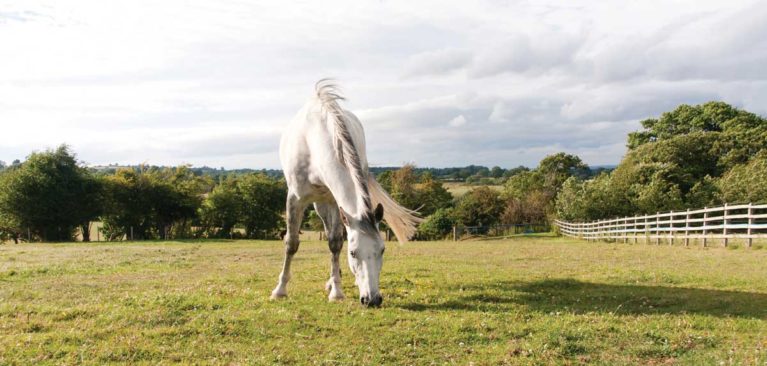Is your horse getting the most out of his grazing? Here are 10 ways to improve it, no matter how much land you have

Watching your horse’s field become more of a mud bath or dusty plain than a thick blanket of grass is a common struggle. Horses are selective grazers, who can leave some areas of their paddock eaten right down to the roots, while other parts are untouched and wild. Habits such as rolling or congregating as a herd can also leave bare patches or poach the ground, especially around gates and water troughs. While paddock maintenance isn’t the most exciting aspect of horse ownership, forage is the biggest and most important part of his diet and, if you get it right, grass could be a cost-effective way to provide it.
1. Top of the crop
Topping is removing the top of long, rough grasses, which horses won’t eat. It’s an important part of paddock maintenance and it’s recommended that you do it once a year in spring or summer. Topping encourages new growth, promotes a thicker turf and helps keep weeds at bay. You shouldn’t turn your horse out onto topped grass immediately – wait until the trimmings have been removed or they’ve dried up completely.
DID YOU KNOW?
As a guideline, you should allocate 1.5 acres of grazing per horse.
2. A harrowing experience
Harrowing when your pasture is dry will help remove shallow weeds and dead grass, while rolling will restore pasture that’s been churned up. Avoid rolling when the soil is overly moist, as this can compact the ground and prevent grass growth. It’s beneficial to harrow and roll your field in the springtime to alleviate winter damage.
3. Don’t miss a bleat
Your horse’s fussy eating can lead to overgrazed patches of ground and long, uneaten areas. Grazing him alongside non-selective grazers, such as sheep, will help to even this out and will also reduce the amount of sugary grass available to him over the spring and summer months.
4. Keep it turning
Having more than one paddock at your disposal is a huge benefit, as it allows you to rotate your horse between them and rest your grass. Sectioning your grazing up with electric fencing will help to prevent over-grazing and encourage faster, thicker regrowth.
5. Testing, testing
Measuring the pH of your soil can give you a useful insight into your pasture’s grass-growing capabilities, and you can buy testing kits online to use at home. The ideal soil pH is 6.5 and it’s best to take samples from February through to April or September through to December. Slightly acidic ground can be remedied by the addition of lime, made from naturally occurring limestone that’s in pellets or powder form. You can spread this around by hand or with a push-along lime spreader.
6. Nutritious and delicious
Soil requires the correct balance of nutrients to produce good-quality grass, and these include nitrogen, phosphorous and potassium. You can buy soil nutrient content testing kits that allow you to send samples off for accurate analysis and you should take your sample two weeks after testing your soil’s pH. Deficiencies can be rectified with specially-formulated fertilisers, which contain the correct ratio of these key nutrients, although you should wait a few days before turning your horse out onto a freshly fertilised field.
TOP TIP
Land that’s fertilised with excessive nitrogen can become too rich for horses, potentially leading to colic and laminitis, so seek expert advice when selecting your fertiliser blend.
7. Gone to seed
Reseeding patchy pasture will encourage new growth and repair over-grazed or bare patches, minimising the opportunity for weeds to fill in the gaps. You can buy specialist seed mixes, which contain beneficial grasses that are ideal for horses, such as brown top and timothy.
8. Pick it up
It’s not the most glamorous job, but daily poo-picking will hugely benefit your pasture’s overall health. Your horse will be encouraged to graze the paddock more evenly, as he won’t touch soiled areas, and it’ll reduce the pasture’s worm burden, too.
9. Dig it out
Keep a look-out for poisonous plants such as ragwort and dig them up as you find them. Not only will this reduce the risk to your horse, but it’ll allow grass to grow in its place, too. A specialist ragwort fork will make this task easier, and you should wear gloves and burn the plants once you’ve cleared them out.
10. Go hardcore
Poached ground near gateways and water troughs is very hard to avoid, but it causes extensive damage to the ground and makes it prone to filling with weeds. Putting down some hard-standing before winter is a great way to help avoid a muddy mess or grass mats can be used to protect the ground, while allowing grass to grow through them.
Grass is greener
Don’t feel you have to do all of these tasks at once – for one thing, your grass won’t thank you, and for another, a lot of these tasks are season and issue dependent. Next time you check your paddock, keep these common pasture pitfalls and their remedies in mind and you’ll soon have your neighbours green with envy.









